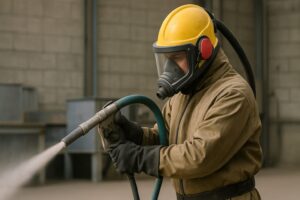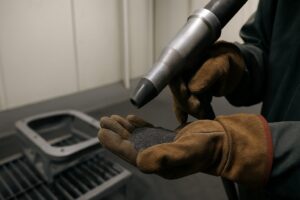Sandblasting is an effective way to remove paint, rust, and grime from surfaces, but it comes with serious safety risks. Operators work with high-pressure abrasives that can damage skin, eyes, lungs, and hearing if the right protection isn’t in place. Understanding and using proper personal protective equipment (PPE) is essential to keep sandblasting crews healthy, productive, and accident-free. Today, we’ll explore the key gear every sandblaster should have, why each piece matters, and some simple tips for using PPE correctly.
Why PPE Matters
Sandblasting propels tiny particles at great speed to strip surfaces clean. Those particles can rebound, creating sharp fragments that can cut skin, embed in eyes, and tear through clothing. Even more dangerous, the airborne dust often contains silica, lead, or other toxic materials. Inhaling this dust can lead to serious respiratory illnesses like silicosis, lung cancer, or chronic bronchitis.
Wearing the right PPE forms a barrier between you and these hazards. It not only prevents immediate injuries, like cuts and eye irritation, but also protects against long-term health issues. Plus, when everyone on the team uses proper gear, project delays from injuries go dow,n and overall morale goes up. PPE is not just a safety formality; it’s an investment in your crew’s wellbeing and your business’s efficiency.
Essential PPE for Sandblasting
Below are the core pieces of equipment every sandblasting operator needs. Each serves a different purpose, but together they provide comprehensive protection.
1. Respiratory Protection
Type: Supplied-air respirator (SAR) or powered air-purifying respirator (PAPR)
Why it matters: Sandblasting generates dust and fine particles that don’t just disappear. Inhaling them can damage lung tissue permanently. SARs provide clean air directly from a safe source, while PAPRs filter ambient air and deliver it under slight positive pressure.
Key features: Look for NIOSH-approved units with replaceable filters rated for abrasive dust and possible contaminants (e.g., P100 filters). Ensure hoses and cartridges are checked and replaced per manufacturer’s guidelines.
2. Protective Clothing
Type: Heavy-duty overalls or disposable coveralls, plus rubber boots or steel-toe work boots
Why it matters: Abrasive media can cut through ordinary fabrics and damage unprotected skin. Coveralls made of abrasion-resistant material shield the body, while sturdy boots protect the feet from falling grit and heavy equipment.
Key features: Choose garments with reinforced seams and high-visibility colors if working near traffic or in dim conditions. Make sure boots are slip-resistant and fit well with coverall legs over the top.
3. Gloves
Type: Abrasion-resistant gloves, often leather or specialty synthetic materials
Why it matters: Sandblasting puts enormous stress on hands. Contact with high-speed particles can cause cuts, punctures, and severe abrasions. Gloves provide essential hand protection and help maintain a firm grip on equipment.
Key features: Look for gloves rated for cut resistance (ANSI/ISEA Level 2 or higher). Make sure the fit allows good dexterity but isn’t so loose that the glove could catch on moving parts.
4. Eye and Face Shield
Type: Full-face helmet or hood with integrated visor
Why it matters: Even if you wear goggles, flying media can ricochet and hit the sides or gaps, risking eye or facial injury. A full-face shield protects your eyes, face, and neck from abrasive particles and potential chemical splashes.
Key features: The visor should be made of impact-resistant polycarbonate and offer clear visibility without distortion. Helmets with built-in air circulation also help reduce visor fogging.
5. Hearing Protection
Type: Earplugs or earmuffs rated for high noise environments
Why it matters: Sandblasting machinery and compressed-air flow generate noise levels that can exceed 100 decibels (dB). Prolonged exposure to such noise can lead to irreversible hearing loss.
Key features: Aim for hearing protection devices with a Noise Reduction Rating (NRR) of at least 25 dB. For the best comfort and seal, consider custom-molded earplugs if available.
Proper Usage and Maintenance
Having the right PPE is only half the battle. It must be used correctly and maintained in good condition. Here are some straightforward best practices:
- Inspect Daily: Before each shift, visually inspect respirators, helmets, gloves, and coveralls for tears, cracks, or wear. A small hole in a glove can defeat its purpose.
- Fit Testing and Training: Respirators must fit snugly. Conduct regular fit tests and provide hands-on training so operators know how to don and doff gear properly.
- Clean and Store Properly: After use, wipe down helmets and respirators with mild detergent, and hang garments to air out in a clean, dry area. Never stuff wet gear into a toolbox.
- Replace Filters and Consumables: Follow manufacturer schedules for changing respirator cartridges, air hoses, and protective clothing. Even if parts look fine, time and exposure degrade materials.
- Document PPE Records: Keep logs of maintenance, inspections, and fit tests. Documentation shows compliance with safety regulations and highlights when replacements are due.
Training and Compliance
Safety regulations from bodies like OSHA (Occupational Safety and Health Administration) set minimum PPE standards for abrasive blasting. Ensuring your team is up-to-date on these guidelines helps you avoid fines and, more importantly, keeps everyone safe.
- Regular Safety Meetings: Hold brief toolbox talks to review PPE requirements, update on any new procedures, and remind operators of inspection routines.
- Certification Programs: Encourage or require operators to complete recognized respirator-fit courses or abrasive-blasting safety workshops.
- Monitoring and Feedback: Supervisors should periodically observe operators to confirm they wear all required PPE correctly. Constructive feedback maintains a culture of safety.
Beyond the Basics: Additional Considerations
Depending on the blasting media and environment, you might need extra protection:
- Chemical-Resistant Suits: If using chemical additives or wet blasting, full-body suits that resist solvents and acids can be necessary.
- Thermal Protection: For abrasive blasting in hot climates or near heat sources, cooling vests under coveralls help prevent heat stress.
- Glove Liners: In cold conditions, thin liners under gloves maintain dexterity and warmth without compromising safety.
Always perform a job hazard analysis before starting any sandblasting project. That way, you can identify unique risks, like confined spaces or proximity to electrical equipment, and select PPE accordingly.
Conclusion
Sandblasting is a powerful tool for surface preparation, but it comes with significant safety hazards. By equipping operators with the right PPE—respirators, protective clothing, gloves, face shields, and hearing protection, you create a safer workspace and protect your most valuable asset: your team. Remember, PPE only works when it’s well-maintained and correctly used, so invest in regular inspections, fit testing, and training. When you prioritize safety, your crew can focus on delivering top-quality results in your paint booth business, project after project.
Specialized Sandblasting Booth Services
We specialize in providing top-quality sandblasting booths and custom finishing solutions tailored to meet the unique needs of various industries. Our expert team designs and manufactures state-of-the-art sandblasting booths that ensure safety, efficiency, and superior performance. From automotive and aerospace to marine and industrial applications, our booths are engineered to handle even the most demanding surface preparation tasks. We offer comprehensive services, including booth installation, maintenance.




